2019 Hyundai Kona run flat
[x] Cancel search: run flatPage 408 of 526
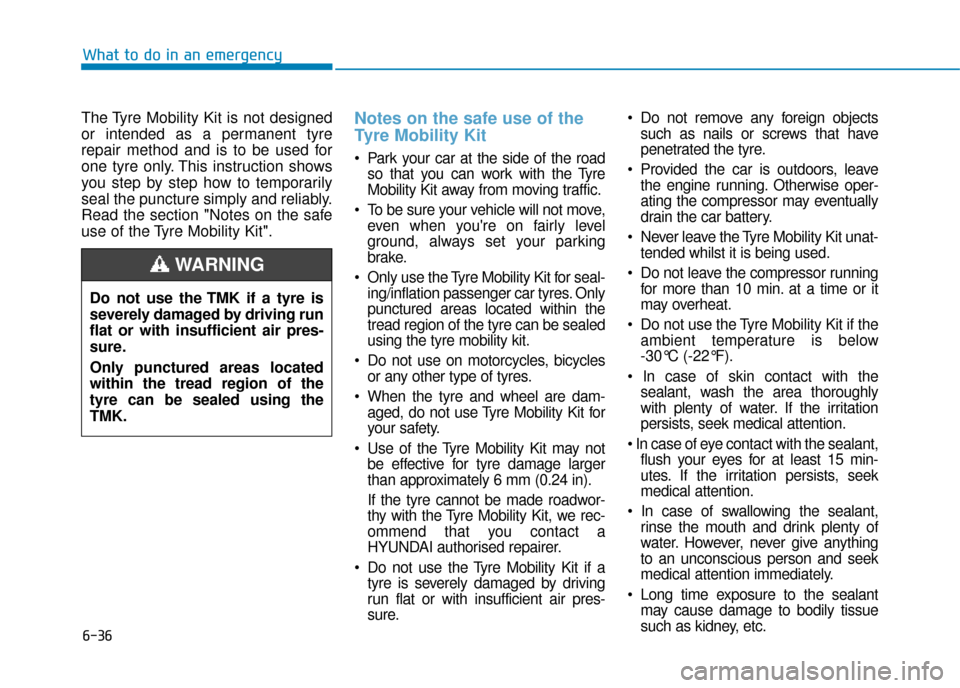
6-36
What to do in an emergency
The Tyre Mobility Kit is not designed
or intended as a permanent tyre
repair method and is to be used for
one tyre only. This instruction shows
you step by step how to temporarily
seal the puncture simply and reliably.
Read the section "Notes on the safe
use of the Tyre Mobility Kit".
Notes on the safe use of the
Tyre Mobility Kit
Park your car at the side of the road so that you can work with the Tyre
Mobility Kit away from moving traffic.
To be sure your vehicle will not move, even when you're on fairly level
ground, always set your parking
brake.
Only use the Tyre Mobility Kit for seal- ing/inflation passenger car tyres. Only
punctured areas located within the
tread region of the tyre can be sealed
using the tyre mobility kit.
Do not use on motorcycles, bicycles or any other type of tyres.
When the tyre and wheel are dam- aged, do not use Tyre Mobility Kit for
your safety.
Use of the Tyre Mobility Kit may not be effective for tyre damage larger
than approximately 6 mm (0.24 in).
If the tyre cannot be made roadwor-
thy with the Tyre Mobility Kit, we rec-
ommend that you contact a
HYUNDAI authorised repairer.
Do not use the Tyre Mobility Kit if a tyre is severely damaged by driving
run flat or with insufficient air pres-
sure. Do not remove any foreign objects
such as nails or screws that have
penetrated the tyre.
Provided the car is outdoors, leave the engine running. Otherwise oper-
ating the compressor may eventually
drain the car battery.
Never leave the Tyre Mobility Kit unat- tended whilst it is being used.
Do not leave the compressor running for more than 10 min. at a time or it
may overheat.
Do not use the Tyre Mobility Kit if the ambient temperature is below
-30°C (-22°F).
sealant, wash the area thoroughly
with plenty of water. If the irritation
persists, seek medical attention.
flush your eyes for at least 15 min-
utes. If the irritation persists, seek
medical attention.
rinse the mouth and drink plenty of
water. However, never give anything
to an unconscious person and seek
medical attention immediately.
may cause damage to bodily tissue
such as kidney, etc.
Do not use the TMK if a tyre is
severely damaged by driving run
flat or with insufficient air pres-
sure.
Only punctured areas located
within the tread region of the
tyre can be sealed using the
TMK.
WARNING
Page 411 of 526
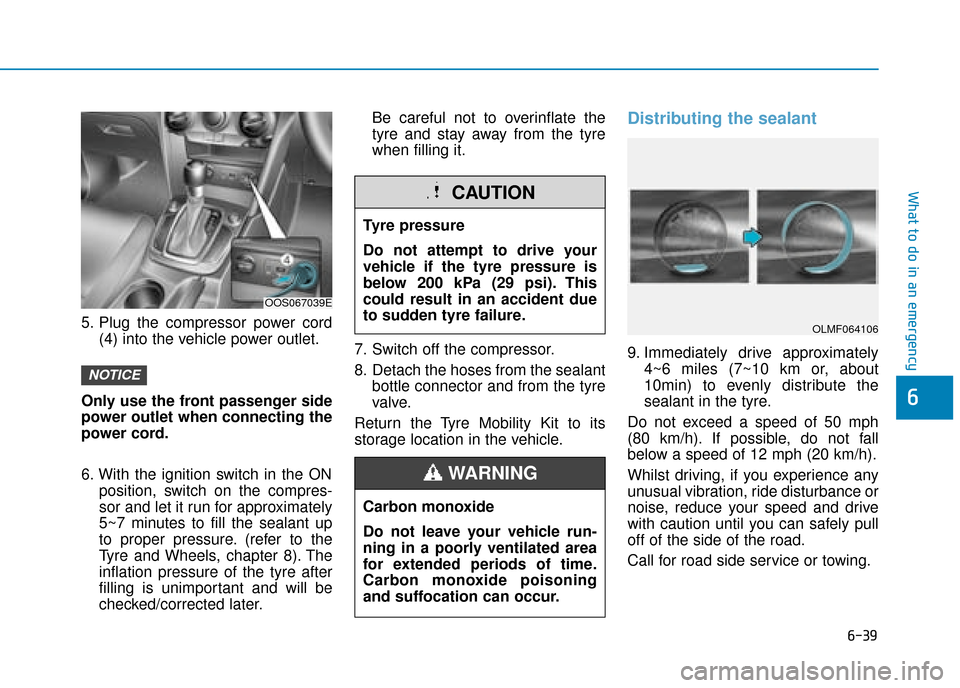
6-39
What to do in an emergency
6
5. Plug the compressor power cord(4) into the vehicle power outlet.
Only use the front passenger side
power outlet when connecting the
power cord.
6. With the ignition switch in the ON position, switch on the compres-
sor and let it run for approximately
5~7 minutes to fill the sealant up
to proper pressure. (refer to the
Tyre and Wheels, chapter 8). The
inflation pressure of the tyre after
filling is unimportant and will be
checked/corrected later. Be careful not to overinflate the
tyre and stay away from the tyre
when filling it.
7. Switch off the compressor.
8. Detach the hoses from the sealant bottle connector and from the tyre
valve.
Return the Tyre Mobility Kit to its
storage location in the vehicle.
Distributing the sealant
9. Immediately drive approximately 4~6 miles (7~10 km or, about
10min) to evenly distribute the
sealant in the tyre.
Do not exceed a speed of 50 mph
(80 km/h). If possible, do not fall
below a speed of 12 mph (20 km/h).
Whilst driving, if you experience any
unusual vibration, ride disturbance or
noise, reduce your speed and drive
with caution until you can safely pull
off of the side of the road.
Call for road side service or towing.
NOTICE
OOS067039E
Tyre pressure
Do not attempt to drive your
vehicle if the tyre pressure is
below 200 kPa (29 psi). This
could result in an accident due
to sudden tyre failure.
CAUTION
Carbon monoxide
Do not leave your vehicle run-
ning in a poorly ventilated area
for extended periods of time.
Carbon monoxide poisoning
and suffocation can occur.
WARNING
OLMF064106
Page 412 of 526
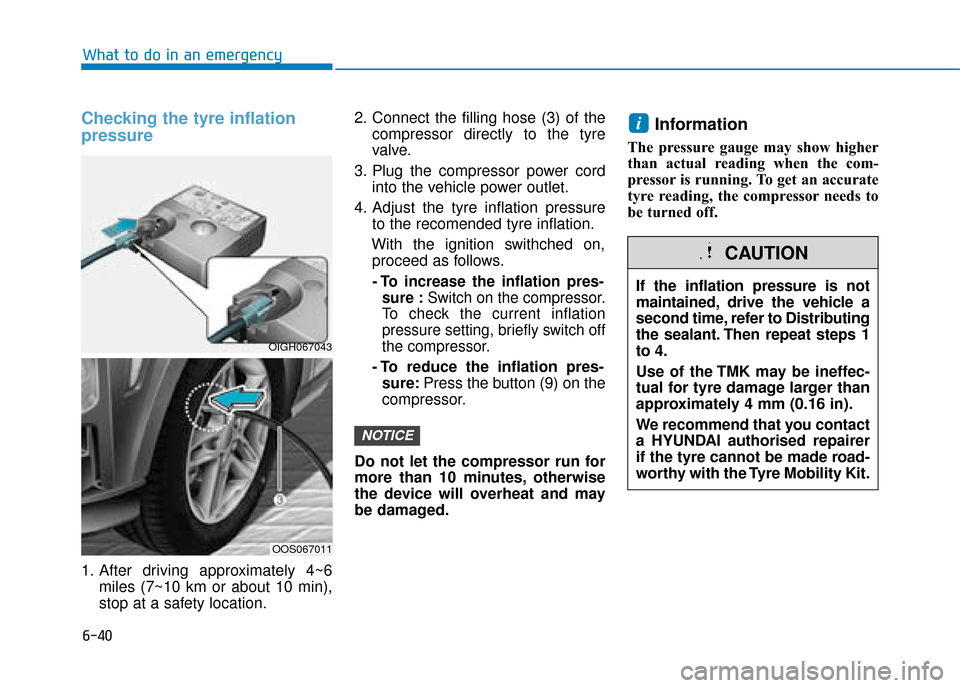
6-40
What to do in an emergency
Checking the tyre inflation
pressure
1. After driving approximately 4~6miles (7~10 km or about 10 min),
stop at a safety location. 2. Connect the filling hose (3) of the
compressor directly to the tyre
valve.
3. Plug the compressor power cord into the vehicle power outlet.
4. Adjust the tyre inflation pressure to the recomended tyre inflation.
With the ignition swithched on, proceed as follows.
- To increase the inflation pres- sure : Switch on the compressor.
To check the current inflation
pressure setting, briefly switch off
the compressor.
- To reduce the inflation pres- sure: Press the button (9) on the
compressor.
Do not let the compressor run for
more than 10 minutes, otherwise
the device will overheat and may
be damaged.
Information
The pressure gauge may show higher
than actual reading when the com-
pressor is running. To get an accurate
tyre reading, the compressor needs to
be turned off.
i
NOTICE
OIGH067043
OOS067011
If the inflation pressure is not
maintained, drive the vehicle a
second time, refer to Distributing
the sealant. Then repeat steps 1
to 4.
Use of the TMK may be ineffec-
tual for tyre damage larger than
approximately 4 mm (0.16 in).
We recommend that you contact
a HYUNDAI authorised repairer
if the tyre cannot be made road-
worthy with the Tyre Mobility Kit.
CAUTION
Page 419 of 526
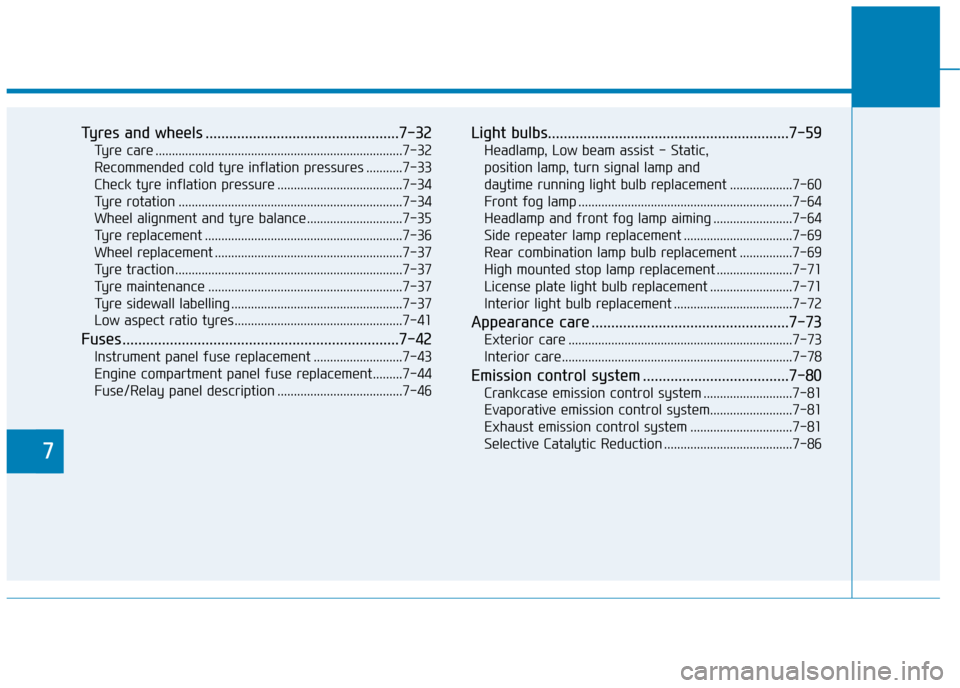
7
Tyres and wheels .................................................7-32
Tyre care ........................................................................\
...7-32
Recommended cold tyre inflation pressures ...........7-33
Check tyre inflation pressure ......................................7-34
Tyre rotation ....................................................................7-34\
Wheel alignment and tyre balance.............................7-35
Tyre replacement ............................................................7-36
Wheel replacement .........................................................7-37
Tyre traction .....................................................................7-3\
7
Tyre maintenance ...........................................................7-37
Tyre sidewall labelling ....................................................7-37
Low aspect ratio tyres...................................................7-41
Fuses ......................................................................7-\
42
Instrument panel fuse replacement ...........................7-43
Engine compartment panel fuse replacement.........7-44
Fuse/Relay panel description ......................................7-46
Light bulbs.............................................................7-59
Headlamp, Low beam assist - Static,
position lamp, turn signal lamp and
daytime running light bulb replacement ...................7-60
Front fog lamp .................................................................7-64
Headlamp and front fog lamp aiming ........................7-64
Side repeater lamp replacement .................................7-69
Rear combination lamp bulb replacement ................7-69
High mounted stop lamp replacement .......................7-71
License plate light bulb replacement .........................7-71
Interior light bulb replacement ....................................7-72
Appearance care ..................................................7-73
Exterior care ....................................................................7-73\
Interior care......................................................................7-\
78
Emission control system .....................................7-80
Crankcase emission control system ...........................7-81
Evaporative emission control system.........................7-81
Exhaust emission control system ...............................7-81
Selective Catalytic Reduction .......................................7-86
Page 481 of 526
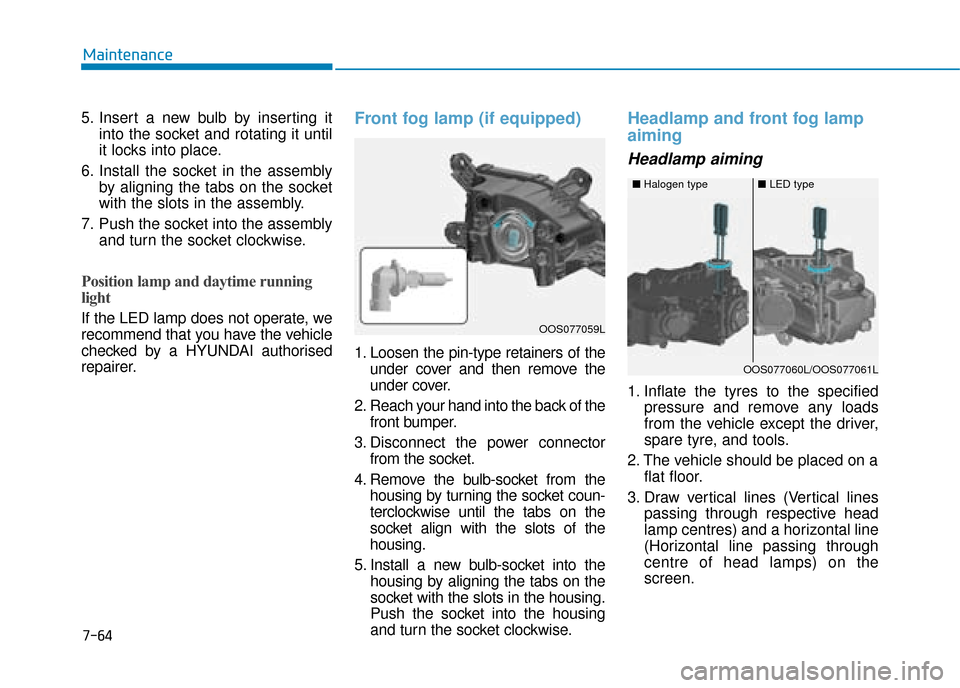
7-64
Maintenance
5. Insert a new bulb by inserting it into the socket and rotating it until
it locks into place.
6. Install the socket in the assembly by aligning the tabs on the socket
with the slots in the assembly.
7. Push the socket into the assembly and turn the socket clockwise.
Position lamp and daytime running
light
If the LED lamp does not operate, we
recommend that you have the vehicle
checked by a HYUNDAI authorised
repairer.
Front fog lamp (if equipped)
1. Loosen the pin-type retainers of theunder cover and then remove the
under cover.
2. Reach your hand into the back of the front bumper.
3. Disconnect the power connector from the socket.
4. Remove the bulb-socket from the housing by turning the socket coun-
terclockwise until the tabs on the
socket align with the slots of the
housing.
5. Install a new bulb-socket into the housing by aligning the tabs on the
socket with the slots in the housing.
Push the socket into the housing
and turn the socket clockwise.
Headlamp and front fog lamp
aiming
Headlamp aiming
1. Inflate the tyres to the specified pressure and remove any loads
from the vehicle except the driver,
spare tyre, and tools.
2. The vehicle should be placed on a flat floor.
3. Draw vertical lines (Vertical lines passing through respective head
lamp centres) and a horizontal line
(Horizontal line passing through
centre of head lamps) on the
screen.
OOS077059L
■Halogen type■LED type
OOS077060L/OOS077061L